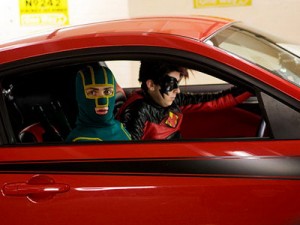by Robert Sims, Special Contributor to TheMovieKit
 Step 1: Don’t go in expecting the next Spider-Man. Kick-Ass may not deconstruct the superhero mythos in the same solemn manner as last year’s Watchmen, but by simultaneously spoofing and paying tribute to the crime-busting activities of costumed crusaders, it offers a fresh take on a well-worn genre.
Step 1: Don’t go in expecting the next Spider-Man. Kick-Ass may not deconstruct the superhero mythos in the same solemn manner as last year’s Watchmen, but by simultaneously spoofing and paying tribute to the crime-busting activities of costumed crusaders, it offers a fresh take on a well-worn genre.
Step 2: Forget about reading every issue of the Mark Millar-penned, John Romita Jr.-illustrated Marvel comic book. You don’t need to go into Kick-Ass knowing every little detail about this non-superpowered superhero’s mythology, especially as the third act deviates from events depicted in later issues of series. Your lack of familiarity with Kick-Ass will make the experience of watching director Matthew Vaughn’s playful origin story all the more enjoyable. The high school student behind the mask is Dave Lizewski (Aaron Johnson), the geek every bully loves to pick on and every girl thinks is gay. How Dave adopts his alter ego is relatively simple: he just decides to become a superhero out of “optimism and naivety.” He has no powers, which is evident the first time tries to stop a crime in progress. He’s busted up so badly that his nerve endings are messed up, so he can barely feel pain. A good thing, too, as the beatings continue. Still, Kick-Ass willingly unites with compatriots Big Daddy (Nicolas Cage) and Hit Girl (Chloë Moretz—yes, (500) Days of Summer’s little sister!) to take down New York City crime kingpin Frank D’Amico (Sherlock Holmes’ villain du jour Mark Strong).
Step 3: Avoid Kick-Ass if you faint at the sight of blood. The film isn’t for your 6-year-old who’s just discovered Iron Man. Working from a script co-written with Kick-Ass’s creators, Vaughn can’t help but stay true to the comic book’s generous helping of graphic violence. And there’s no interest in playing by the usual PG-13 comic-book film rules,either. For example, Kick-Ass’s idea of father-daughter bonding involves Cage firing couple rounds at a bulletproof-vested Moretz so she knows how it feels to be shot. How sweet. Cage, as you may already suspect, storms through Kick-Ass like a psychotic version of the smiling and devoted 1950s TV dad. He also does a hilarious job of channeling Adam West when in costume (his resembles Batman’s, Hit Girl’s resembles Batgirl’s). Cage, though, doesn’t perpetrate much of the violence in Kick-Ass. That task is given to Moretz. It’s impossible not to be both impressed and disturbed that this angel-faced cutie could cause as much harm and damage as Arnie, Bruce or Sly combined. This is in stark contrast to Johnson, who is more human punch bag than one-man army. You get to the point where you wince when Johnson takes a beating. Superbad’s Christopher Mintz-Plasse is all mouth and little action by design, but that’s OK. His Red Mist—a rail-thin superhero sidekick created for nefarious reasons—is mostly there for comic relief.
Step 4: No need to stress out pondering this question Dave asks himself: “How come no one’s never wanted to be a superhero?” D’oh. We can’t leap tall buildings in a single bound. We feel pain. We die. The self-aware Kick-Ass doesn’t treat its superheroes as superbeings—one protagonist dies a horrible death—but Vaughn et al. do dissect the question Dave poses to the point of redundancy. Also, there are times when you feel Kick-Ass thinks it’s a little more clever and radical than it is. But you forgive Kick-Ass for its arrogant streak because of its switchblade-sharp wit and unwillingness to compromise.
Level of difficulty in watching Kick-Ass: Like your superheroes to save the day PG-13 style? Stick to Spider-Man and Fantastic Four. Kick-Ass lives up to its name, even if its superhero rarely does.

